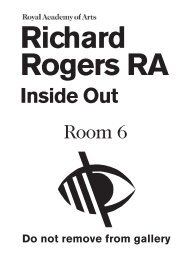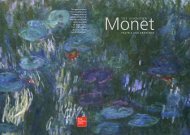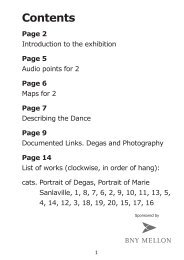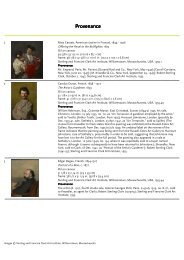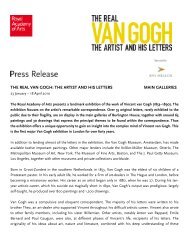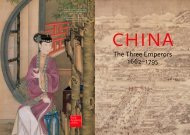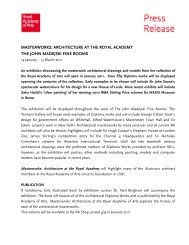rodin - Royal Academy of Arts
rodin - Royal Academy of Arts
rodin - Royal Academy of Arts
You also want an ePaper? Increase the reach of your titles
YUMPU automatically turns print PDFs into web optimized ePapers that Google loves.
18<br />
became a way <strong>of</strong> sustaining the emotions inspired by her body.To<br />
some he would later add a pale wash to bring out a sense <strong>of</strong> volume<br />
and differentiate the figure from the background, <strong>of</strong>ten cutting out and<br />
re-pasting the isolated figure on a new piece <strong>of</strong> paper or combining it<br />
with another drawing.<br />
Cat. 265 Rodin was fascinated by movement and its sense <strong>of</strong> implied<br />
action. In this study <strong>of</strong> a woman with her arms crossed, the pose owes<br />
much to his love <strong>of</strong> dance, particularly the more formal and restrained<br />
movements <strong>of</strong> Oriental dancers.The curving arabesque from her<br />
lowered left shoulder down to waist and buttock and thigh provides<br />
the pivotal force <strong>of</strong> energy reflected in the swelling belly and raised<br />
arms.<br />
The model appears to be wearing a cape, which billows out to right and<br />
left. Do you think she was actually wearing one or do you think that Rodin<br />
added it, along with the fluid lines across and around her thighs, to suggest<br />
the sense <strong>of</strong> movement implicit in the pose?<br />
The late drawings can be seen as a celebration <strong>of</strong> feminine sexuality.What<br />
might have been the reaction if one reversed the gender <strong>of</strong> artist and<br />
model?<br />
THE PARTIAL FIGURES<br />
Rodin felt that one part <strong>of</strong> the sculpture, usually the torso, contained<br />
the core <strong>of</strong> energy that radiated out into the rest <strong>of</strong> the figure, and it<br />
was not unusual for him to make studies <strong>of</strong> only part <strong>of</strong> the figure.<br />
Given his propensity to mix and match, using one part <strong>of</strong> a figure<br />
combined with part <strong>of</strong> another, the idea <strong>of</strong> sculptural form as a direct<br />
representation <strong>of</strong> nature was subverted in favour <strong>of</strong> artistic<br />
manipulation. Rodin felt free to exhibit his studies as well as radically<br />
altering existing figures by the removal <strong>of</strong> extremities.<br />
Cat. 205 This figure, known as The Muse,The Inner Voice or Meditation,<br />
demonstrates how Rodin used and reused a figure in different ways,<br />
finding new creative possibilities over an extended period <strong>of</strong> time.<br />
Originally a small figure in the right-hand side <strong>of</strong> the tympanum <strong>of</strong> The<br />
Gates <strong>of</strong> Hell, she can be seen with that characteristic twist <strong>of</strong> the body,<br />
head lowered and her right hand touching her hair. Detached from The<br />
Gates and enlarged, the right hand now cradles the face and the left<br />
hand touches the upper breast. It has been suggested that the<br />
inspiration for the sculpture was Camille Claudel’s body and attitude,<br />
which may account for its use in a proposed monument to Victor<br />
Hugo as one <strong>of</strong> three muses, initially with the arms but later without,<br />
and with the knee and upper leg covered in drapery. By severing this<br />
drapery Rodin arrived at the figure before us.<br />
The calm, classical head suggests an antique Venus, while the<br />
torsion in the pose <strong>of</strong> the body reminds us more <strong>of</strong> Michelangelo.<br />
Removal <strong>of</strong> the arms has created a more flowing, continuous silhouette<br />
and opens up the face to light.The feeling is <strong>of</strong> withdrawal into the self;<br />
Cat. 265<br />
Woman with Folded Arms and Flexed Legs<br />
Dancing with Fluttering Veils, c. 1898<br />
Graphite and stump on cream-coloured<br />
paper<br />
30.6 x 19.9 cm<br />
Musée Rodin, Paris/Meudon, D. 2363. Donation Rodin,<br />
1916<br />
Photo © Musée Rodin/Jean de Calan<br />
‘A work <strong>of</strong> art is always noble,<br />
even when it translates the<br />
stirrings <strong>of</strong> the brute, for at that<br />
moment the artist who has<br />
produced it had as his only<br />
objective the most conscientious<br />
rendering possible <strong>of</strong> the<br />
impression he has felt.’<br />
RODIN, 1907<br />
19




